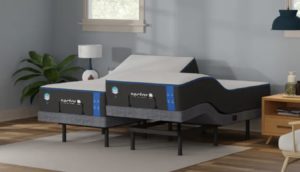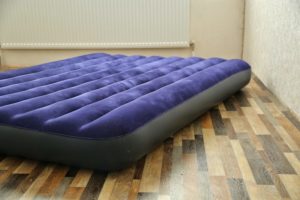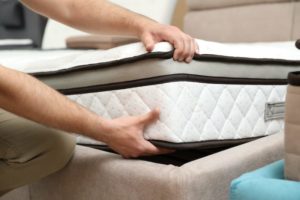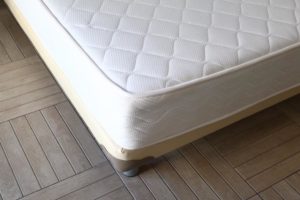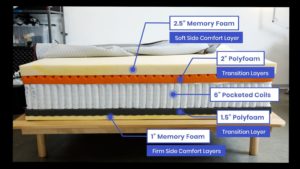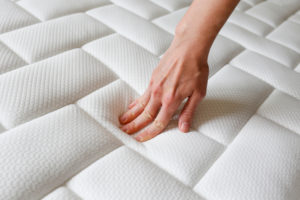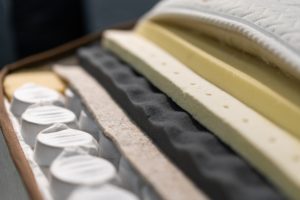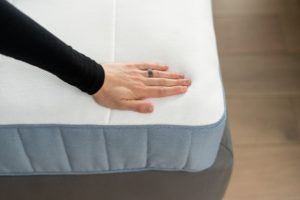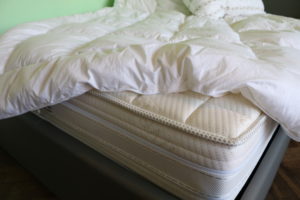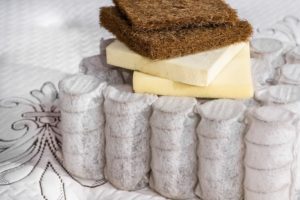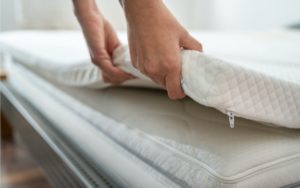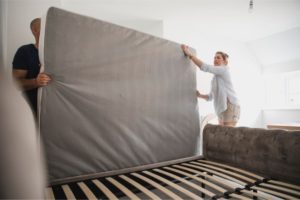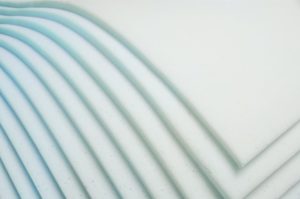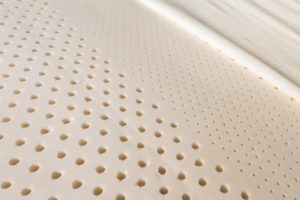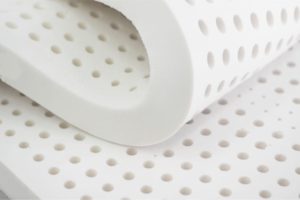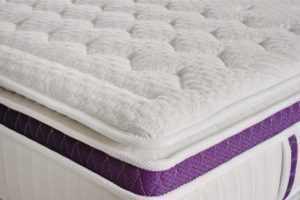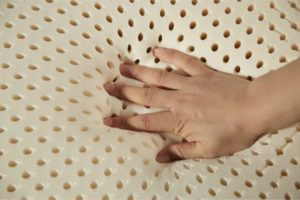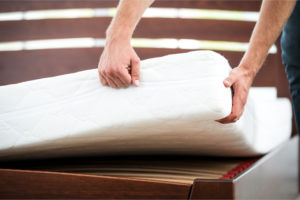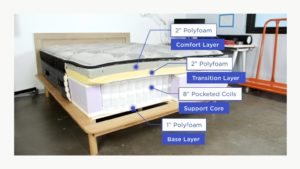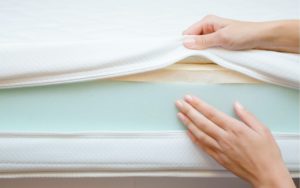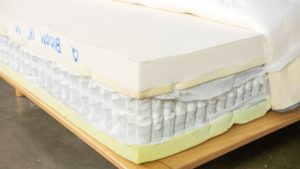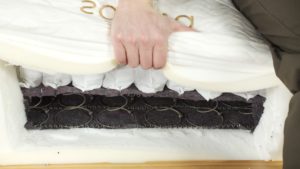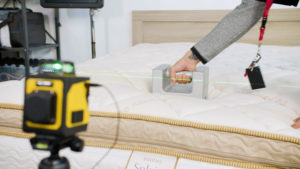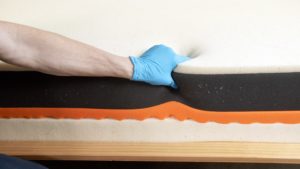What Are the Differences Between Innerspring and Memory Foam Mattresses?
There are many types of mattresses on the market today. Between memory foam, innerspring, latex, and hybrid models, things can get confusing for mattress shoppers. We’ll compare two of the most common mattress styles: memory foam and innerspring. What are the differences between innerspring and memory foam mattresses?
Let us help you find the perfect bed
Answer a few questions to find the right mattress for your unique needs
What Are Innerspring Mattresses?
Mattresses generally have two distinct sections: a support core that acts as the base for the bed, and a softer comfort system made up of more responsive materials that provide cushioning near the surface. Support cores are typically made of high-density polyfoam, metal coils, or latex, while comfort systems incorporate cotton, wool, polyfoam, memory foam, latex, and more, depending on the model.
Innerspring beds make use of metal coils in their support cores that provide a strong, resilient base, while the comfort layer will be relatively thin, at around 2 inches or less. If the comfort layer is greater than 2 inches thick, the mattress will generally be considered a hybrid mattress, rather than an innerspring.
The innerspring mattress has been a popular choice for more than 100 years. The design is thought to have originated in the 1870s, and it remains popular today. Modern innerspring beds are relatively inexpensive to produce, so they are a popular budget-friendly option.
What Are Memory Foam Mattresses?
Memory foam mattresses are made entirely of foam, with at least one memory foam comfort layer. They may have multiple layers of foam material, but they will not utilize any metal springs such as those found in innerspring and hybrid models. Instead, the support cores of memory foam mattresses tend to be made up of high-density polyfoam.
Keep in mind that memory foam may be used in the comfort layers of hybrid and innerspring models – but it won’t typically be marketed as a “memory foam mattress” unless it’s an all-foam model.
The term “memory foam” refers to viscoelastic polyurethane foam. It’s denser and more viscous than materials like polyfoam, and offers a very unique, soft-yet-supportive feel. Memory foam was first developed by NASA in the 1960s for use in spacecraft. It has since been adapted for commercial use, namely in mattresses.
This foam material has unique properties that make it well suited to mattresses. Its main selling point is that it is very adaptable. When met with body heat and pressure, memory foam will slowly conform to meet the shape of the body. This effect is responsible for memory foam’s signature body-hugging feel.
What Are the Differences Between Innerspring and Memory Foam Mattresses?
| Innerspring | Memory Foam | |
|---|---|---|
| Support Core | Metal coils | High-density polyfoam |
| Comfort Layer | Thin, usually fabric or polyfoam | Memory foam |
| Motion Transfer | Moderate | Very little |
| Temperature Neutrality | Neutral/sleeps cool | Moderate/sleeps warm |
| Pressure Relief | Low to moderate | Moderate to high |
| Overall Feel | Firm, flat surface with minimal contouring | Soft and body-hugging with ample contouring |
| Average Cost | $600-$1,000 | $800-$1,200 |
| Average Lifespan | 5.5-6.5 years | 6-7 years |
| Recommended For | Individuals over 230 lbs Those who sleep hot Sleepers who prefer a flat, even mattress surface | Those who are easily disturbed by partner’s movements Sleepers who prefer a close conforming feel |
In addition to their construction and design characteristics, innerspring and memory foam mattresses perform differently in a number of categories.
Feel
Many people feel like they are sleeping “on” innerspring mattresses, and “in” memory foam mattresses. Memory foam allows the body to sink into it, creating a close-conforming sleep experience. Innerspring beds tend to feel more even and supportive.
Support
Both mattress styles can provide good support to a sleeper’s body, but they achieve that support in a different way.
Innerspring beds offer more even support throughout the surface of the mattress. Stiff metal coils resist compression, creating a supportive flat surface for the body to rest on.
Memory foam lets the body sink in substantially more, creating a more contoured sleep surface. However, quality memory foam mattresses are still very supportive. Foam density will influence a bed’s supportiveness, with denser foams being more durable and supportive. Most sleepers will be happy with support and cushion of a medium-density memory foam, though this will vary depending on your needs.
For individuals over 230 lbs, the firm support of innersprings will likely outperform memory foam.
Conforming
Conforming is a measure of how well a mattress surface adapts to the shape of the sleeper’s body. Memory foam offers excellent conforming. When it is exposed to body heat and pressure, it responds by making an impression on the sleep surface that closely conforms to the body.
Innerspring mattresses offer a relatively flat, even sleep surface with minimal contouring.
Pressure Relief
Pressure relief refers to a mattress’s ability to properly cushion and support the body’s pressure points to help relieve pain and discomfort and promote proper spinal alignment.
Memory foam tends to outperform innerspring beds when it comes to pressure relief, thanks to its superior conforming. Innerspring mattresses have thinner comfort layers and are typically firmer, so pressure relief is often minimal unless sleepers require a firm, sturdy sleep surface.
Temperature Neutrality
Temperature neutrality refers to a mattress’s ability to maintain a comfortable sleeping temperature. In this category, innerspring beds almost always outperform memory foam mattresses.
As a result of its close hug, memory foam allows little room for air to flow around a sleeper, thereby trapping heat against the body. Foam layers and foam support cores in memory foam beds also tend to be less breathable, making it hard for heat to dissipate through the bed as well. On the other hand, innerspring mattresses have much better airflow on the surface and through the bed, which typically leads to a cooler sleep experience.
Cost
Comparing the costs of mattresses is not always so straightforward, as various price-points are available. You can find ultra-budget models for as little as $200, or ultra-luxury models for $2,000 or more.
With that said, innerspring and memory foam models of comparable quality will typically be priced similarly. Our research identified that the average cost of a quality innerspring mattress was around $800, compared to around $1,000 for memory foam.
There are many budget-friendly innerspring and all-foam models available on the market. Memory foam is a specialized type of foam material, so it is rarer to find a very low-cost bed made with memory foam, but not impossible.
Durability & Lifespan
Memory foam mattresses tend to last a bit longer than innerspring models. Our research identified an average lifespan of 6-7 years for memory foam, compared to 5.5-6.5 years for innersprings.
Many factors contribute to the useful lifespan of a mattress. For memory foam, the density rating will have a substantial impact on a bed’s lifespan. For innerspring beds, the coil design and thickness will have the biggest effect on durability.

Still have questions? Ask our community!
Join our Sleep Care Community — a trusted hub of sleep health professionals, product specialists, and people just like you. Whether you need expert sleep advice for your insomnia or you’re searching for the perfect mattress, we’ve got you covered. Get personalized guidance from the experts who know sleep best.



